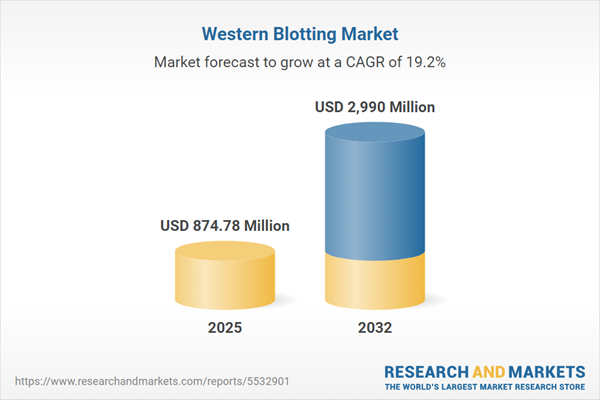Speak directly to the analyst to clarify any post sales queries you may have.
The Western Blotting Market is undergoing significant evolution as robust demand for reliable protein analysis drives continuous methodological innovation and expansion across sectors. This report delivers an actionable overview tailored for leaders planning strategic investments in molecular diagnostics, drug discovery, and advanced research workflows.
Market Snapshot: Western Blotting Market Size and Growth
The western blotting market grew from USD 734.75 million in 2024 to USD 874.78 million in 2025. With an anticipated CAGR of 19.19%, it is forecast to reach USD 2.99 billion by 2032. This trajectory is shaped by technological adoption, rising diagnostic application, and the demand for high-throughput, reproducible protein detection solutions across global research and clinical landscapes.
Scope & Segmentation Across the Western Blotting Market
This comprehensive report provides granular analysis of the following areas to guide decision-makers:
- Product Categories: Instruments (imaging systems, transfer systems), reagents and consumables (antibodies, buffers and substrates, detection kits, protein ladders and markers), software and services (data analysis software, technical support services).
- Application Domains: Basic research, disease diagnostics, drug discovery, and proteomics.
- Detection Modalities: Chemiluminescence, colorimetric, and fluorescent detection types.
- End User Profiles: Contract research organizations, hospitals and diagnostic centers, pharmaceutical and biotechnology companies, and research institutes and academics.
- Regional Coverage: Americas (North America—United States, Canada, Mexico; Latin America—Brazil, Argentina, Chile, Colombia, Peru), Europe, Middle East & Africa (including United Kingdom, Germany, France, Russia, Switzerland, and others in Europe; UAE, Saudi Arabia, Turkey, Israel in the Middle East; South Africa, Nigeria, Egypt, Kenya in Africa), and Asia-Pacific (China, India, Japan, Australia, South Korea, Indonesia, Thailand, Malaysia, Singapore, Taiwan).
- Company Coverage: Key profiles include Thermo Fisher Scientific, Danaher Corporation, Merck KGaA, Bio-Rad Laboratories, Agilent Technologies, Abcam, PerkinElmer, Promega, LI-COR Biosciences, and Bio-Techne Corporation.
Primary Keyword Integration: Western Blotting Market
Key Takeaways for Senior Decision-Makers
- Western blotting remains foundational for precise protein detection, and continuous advancement in automation and multiplexing has improved operational efficiency and reproducibility.
- Technological innovation has expanded clinical applications, with AI-enabled imaging and rapid microfluidic transfer technologies enhancing scalability and data quality.
- The versatility of applications extends from academic research to clinical diagnostics and therapeutic validation, creating diverse growth opportunities in both established and emerging regions.
- Competitive positioning is driven by partnerships between instrument manufacturers and software providers—enabling complete, unified solutions aligned to evolving laboratory expectations.
- Targeting sustainability and supply chain resilience by localizing reagent production and investing in eco-friendly packaging is increasingly vital as organizations adapt to changing regulations and market demands.
Tariff Impact on Supply Chains and Cost Structures
Recent U.S. tariff adjustments on imported antibodies, detection kits, and imaging equipment have altered procurement strategies, tightening margins for consumables and prompting a shift toward domestic suppliers and inventory optimization. These changes are leading to strategic stockpiling, accelerated vertical integration, and new collaborative agreements. As the landscape continues to evolve, proactive supply chain management will be essential to sustaining research continuity and cost-effective delivery.
Rigorous Methodology & Data Sources
Findings in this report are grounded in a multi-stage methodology combining in-depth secondary research from scientific journals and regulatory publications with primary interviews from subject matter experts. Data triangulation, advanced statistical analysis, and peer review ensure insights are robust, transparent, and reproducible—serving the needs of stakeholders who require validated, actionable intelligence.
Why This Report Matters: Strategic B2B Insights
- Supports portfolio planning with comprehensive coverage of product and technology trends across all major regions and user groups.
- Delivers evidence-based insights into competitive dynamics, supply chain challenges, and regional growth opportunities for informed strategic decisions.
Conclusion
This report equips industry leaders with an in-depth understanding of market drivers, segmentation, and technology evolution. It is a practical resource to guide planning, investment, and risk mitigation as the sector advances.
Additional Product Information:
- Purchase of this report includes 1 year online access with quarterly updates.
- This report can be updated on request. Please contact our Customer Experience team using the Ask a Question widget on our website.
Table of Contents
3. Executive Summary
4. Market Overview
7. Cumulative Impact of Artificial Intelligence 2025
Companies Mentioned
The companies profiled in this Western Blotting market report include:- Thermo Fisher Scientific Inc.
- Danaher Corporation
- Merck KGaA
- Bio-Rad Laboratories, Inc.
- Agilent Technologies, Inc.
- Abcam plc
- PerkinElmer, Inc.
- Promega Corporation
- LI-COR Biosciences, Inc.
- Bio-Techne Corporation
Table Information
| Report Attribute | Details |
|---|---|
| No. of Pages | 182 |
| Published | October 2025 |
| Forecast Period | 2025 - 2032 |
| Estimated Market Value ( USD | $ 874.78 Million |
| Forecasted Market Value ( USD | $ 2990 Million |
| Compound Annual Growth Rate | 19.1% |
| Regions Covered | Global |
| No. of Companies Mentioned | 11 |









